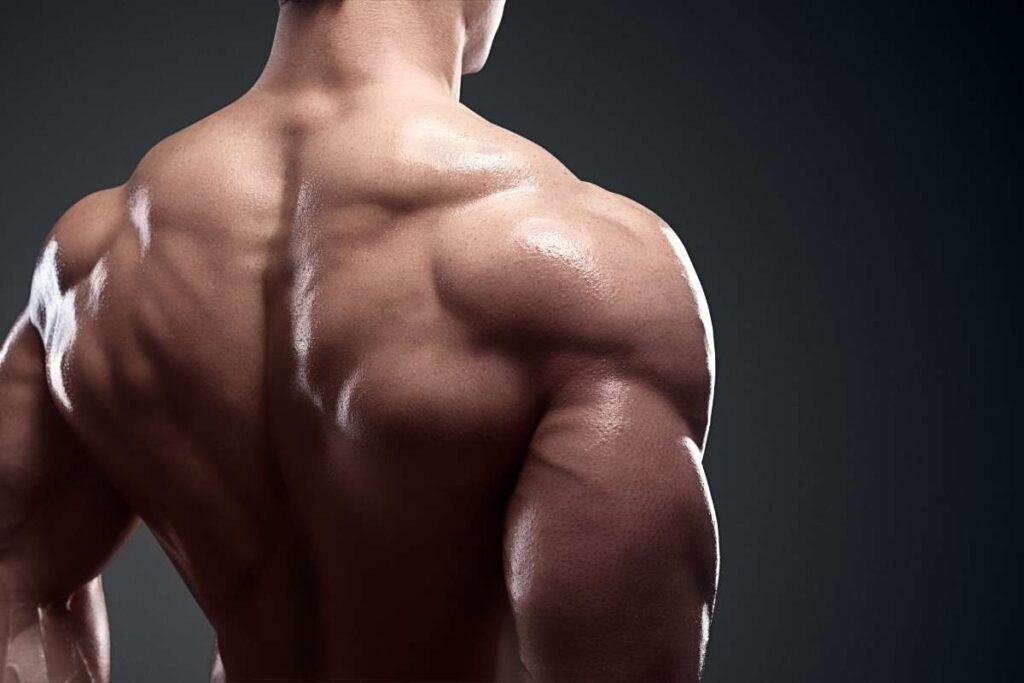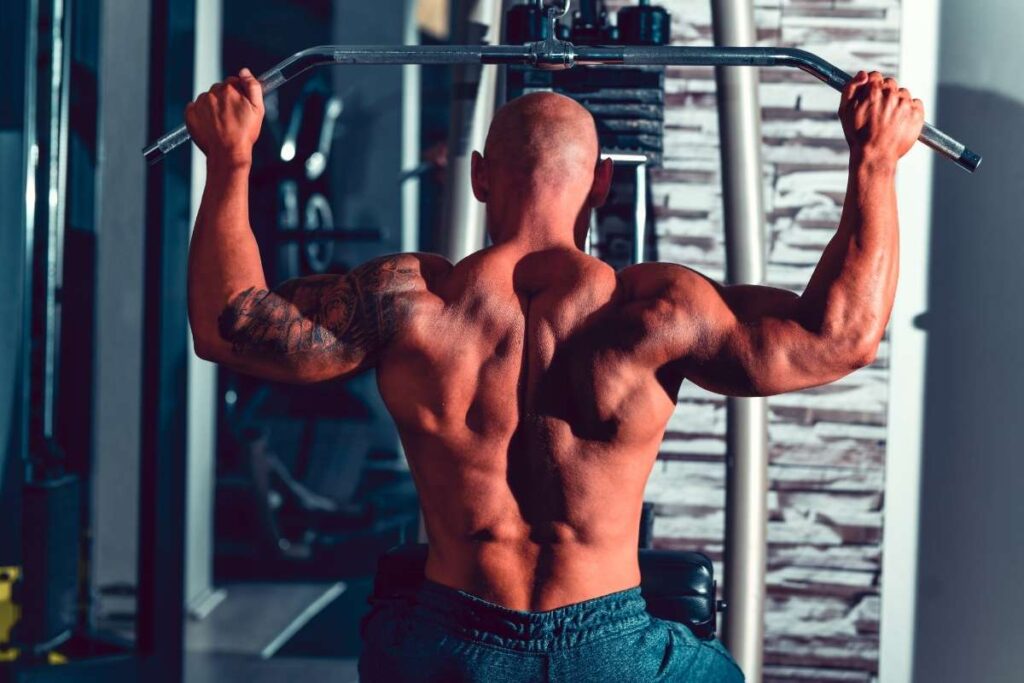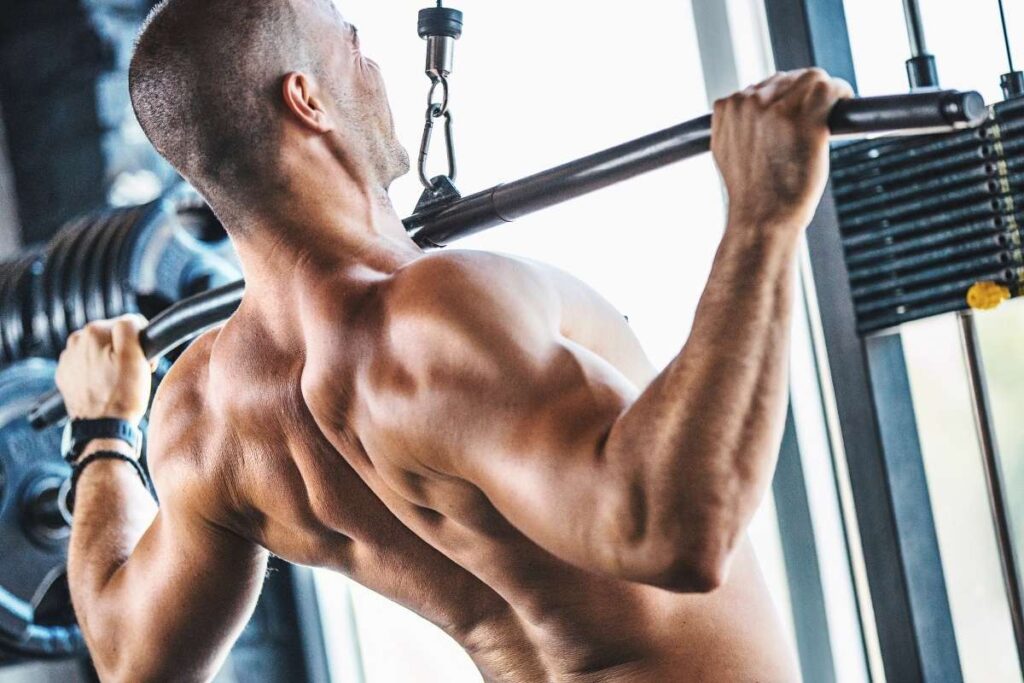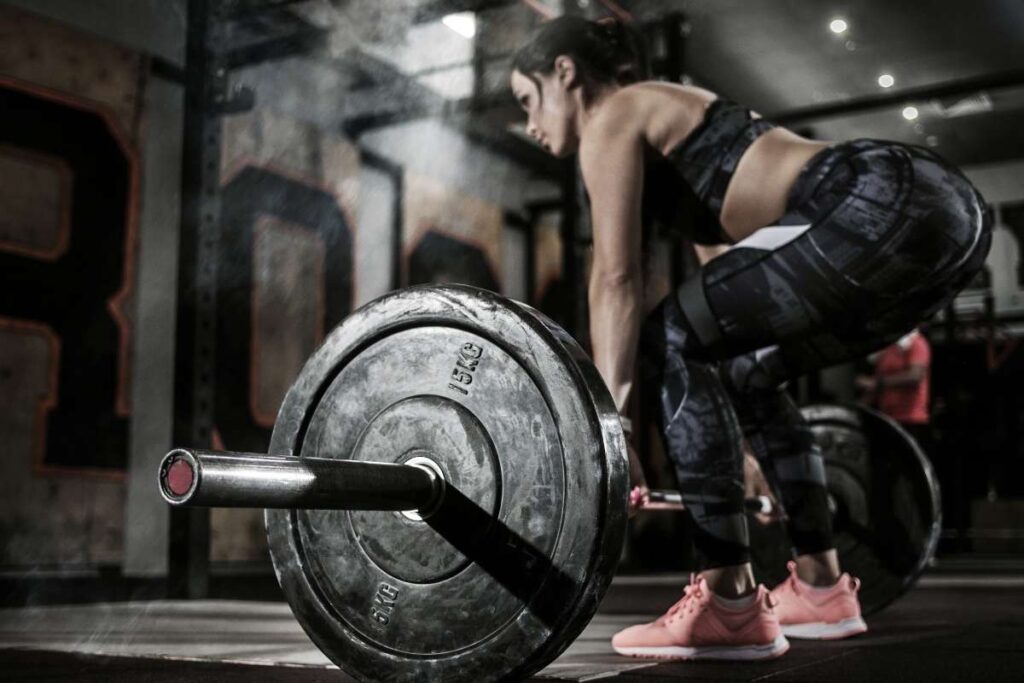What's inside
When was the last time you targeted the middle back in the gym?
The middle back is an area of the body that is forgotten about when training.
Areas such as the upper back, chest, and arms tend to take the spotlight as they showcase our physique.
However, this area of the spine houses some of the most effective postural muscles in the body. What it lacks in aesthetic impact, it more than makes up for with its strength and functional capabilities.
Over my time as a trainer and therapist, I have spent years educating my clients to help improve their physiques and lifts. A strong, functional middle back matters; it contributes to the ability to train those more aesthetic areas.
Today, I’m going to share with you the top 10 middle back exercises to build a strong back and improve your lifts.
Let’s jump in.
What is the Middle Back?
The middle back is located halfway up the spine at the thoracolumbar joint.
The muscles of this area are responsible for maintaining the posture of the torso and shoulder. They’re also responsible for sustaining a neutral spine when we lift.
Anatomy of the Middle Back

Here is a list of anatomy present in the middle back.
- Latissimus Dorsi
- Rhomboids
- Middle And Lower Trapezius
- Erector Spinae
- Thoracic Vertebrae
- Lumbar Vertebrae
Main Benefits of Exercising the Middle Back
Related: Hypertrophy Vs Strength Training

Here are the main reasons why you need to get serious about training the middle back.
Great Posture
This area of the spine contains many of the muscles responsible for maintaining correct posture.
Each vertebra in the spine is designed to work together, maintain posture, and perform a degree of rotation, flexion, extension, and lateral flexion.
However, when our posture is poor, our middle back will tighten to hold us upright, at the loss of quality range of motion.
This can result in disc-related injuries, neck pain, impaired shoulder function, and at times, difficulty breathing.
Fortunately, when we strengthen the middle back, we train muscles including our erector spinae, lower traps, and rhomboid, all of which improve function and posture.
Improved Shoulder Health
Training in the middle back can help to improve shoulder health.
Many of the muscles that originate from the middle back such as the rhomboids, and lower traps play an important role in shoulder posture.
Middle back exercises provide movements such as retraction and downward rotation of the shoulder blades.
Reduce Neck Pain
By exercising the middle back, we can reduce neck-related pain.
When people suffer from neck pain, it is often due to poor posture.
The issue is that the upper trap and the occipital muscles need to work to sustain posture in absence of support from the middle back.
When we engage the muscles of the middle back and correct posture, we prevent the head from shifting forward.
This distributes the load through the spine, reducing tension on the upper traps and pecs.
Greater Strength
Training in your middle back is a great way to increase your overall strength inside the gym and out.
The area of the middle back plays a crucial role in maintaining a neutral spine during many lifts in the gym, including deadlifts, squats, and rows.
Maintaining a neutral spine is important as the movement of the spine under load can increase the risk of disc-related injuries.
When we strengthen the middle back, we increase our ability to isometrically contract and hold the position for the duration of the lift.
This creates a strong foundation, which improves our capacity to lift.
Drawbacks of Weak Middle Back
Below is a list of drawbacks that come with a weak middle back.
Impaired Shoulder Function
When our middle back is weak it can indirectly affect our shoulder function.
Many of the muscles that originate from the middle back attach further up the body to the arms and scapula.
When these muscles are weak, it can present issues for the movement of our shoulder blades, our shoulder posture, and overall posture.
The muscles of the middle back, such as the middle and lower trapezius, are responsible for movement such as scapula downward rotation.
This allows the arm to move up overhead.
When the middle back is weak and the scapula isn’t moving, this will result in a poor range of motion overhead and potential shoulder impingement.
Weak-Looking Physique
A lack of middle back strength can result in a weak-looking, slouched physique.
By strengthening the middle back, we give the appearance of a broader chest.
A proud chest can increase our confidence, make us appear more sociable, and better showcase a fit physique.
Greater Chance of Injury
Middle back weakness can result in injury to many different areas of the body, including disc-related injuries, neck pain, lower back pain, and shoulder injuries..
The middle back has attachment points for erector spinae, paraspinal muscles, and upper back and shoulder muscles.
By focusing on your middle back with just a few exercises per week, you can improve function and reduce the occurrence of injury.
Poor Performance
The body itself functions as a whole when performing in the gym. A weak middle back can result in poor performance, and ultimately, sub-par results.
Exercises such as squats, deadlifts, and rows all require the firm foundation of a strong back.
However, when there is weakness in this chain such as a weak middle back, it can compromise our function.
It is here that pulling during a deadlift becomes weaker.
Pressing overhead becomes harder, and rowing just becomes all arms.
When we strengthen the middle back, we complete the link in the chain and improve our ability to perform virtually every movement in the gym.
What are the reasons for having a weak middle back?

Here is a list of reasons why your middle back may be weak and some solutions to help you strengthen it.
Sedentary Lifestyle
A sedentary lifestyle is one of the most common reasons for a weak middle back.
Many of our daily tasks revolve around us sitting, which can place us in a hunched or slouched position.
When this happens, the muscles of the middle back are holding on, but in a much weaker position.
To remedy this, getting up regularly, stretching the chest, and moving the shoulder blades back can help to keep the middle back muscles active.
No Strength Training
Lack of strength training is another reason for a weak middle back.
While the muscles and joints in this area are incredibly strong, this doesn’t mean they are impervious to poor posture and incorrect lifting habits.
Performing middle back muscle exercises once per week for as little as 15 minutes can go a long way to strengthening these muscles.
Poor Spinal Mobility
Poor spinal mobility is a reason that many people suffer from middle back weakness.
When our middle back is weak and our posture is poor, it’s not only the muscles that can be tight but the joints themselves.
When this happens, we begin to slouch. As a result, the joint also becomes restricted.
When slouching, it can be more difficult to retract the shoulder blades and completely extend our spine.
To improve our posture and our ability to contract the muscles of the middle back, you should aim to perform thoracic spine mobility exercises.
This can help you maintain a healthy range of motion through your vertebrae, improve posture, and your ability to activate your middle back.
Incorrect Form
Incorrect form when training can contribute to middle back weakness.
When performing movements such as rows or pulls in the gym, our technique can drop off due to poor coaching or too much weight.
If this happens, we may not be squeezing the muscles of the middle back, instead predominately pulling back with the arms.
This reduces the efficacy of the exercise.
To ensure you are getting the most out of your sets, focus on activating and squeezing the muscles of the middle back before each rep.
This will help draw your focus to the middle back muscles, ensuring you are hitting them with every rep.
Poor Mind-Muscle Connection
Having poor awareness of your middle back is yet another reason your middle back is weak.
When we train, we must activate and tense our target muscles. This can not only help us be more aware of them when we are training but when we are performing daily tasks.
If you struggle with contracting your middle back and building your mind-muscle connection, start with a light weight and attempt to squeeze the muscle.
This will provide you the resistance to focus on the muscle.
Once you have established that connection, load up the weight and continue to squeeze.
This will improve the ability to target the muscles and recruit them at will for the remainder of the workout and future workouts.
Want to give yourself a physique overhaul? Checkout Complete Guide: Back and Bicep Workout with 15 Powerful Exercises For Muscle Growth
Top 10 Middle Back Exercises to Include in Your Workout Routine

Here’s a list of the top 10 middle back exercises to give you a strong back.
1. Lat Pulldown
Related: 18 Best Pull Up Alternatives
A staple in any back workout, the lat pulldown is an excellent exercise for targeting the middle back.
Due to its slightly leaned-back position, we can target the muscle of the middle back with great accuracy.
Equipment Requirements
- Lat Pulldown Machine
How To Perform Lat Pulldown
- Grab the bar slightly wider than shoulder-width apart and take a seat on the machine.
- Place knees under the knee pads.
- Lean back slightly to allow for the bar to come down.
- Start by pulling the bar down toward your collarbone.
- Once the bar reaches your collarbone, slowly release it back to the starting position. Repeat.
Benefits
- Builds mass
- Increases strength
Pro Tip
- Lean back in the seated position. This will allow the bar to pass the face and chin.
- Focus on pulling elbows back. This will help you target the middle back.
2. Seated Row
The seated row is one of the best middle back exercises for many levels. It offers a simple yet effective pulley system that provides continuous resistance to the lifter.
The machine’s point of resistance is also placed to row toward the waist, making it perfect for targeting the middle back.
Equipment Requirements
- Seated Row Machine
How To Perform Seated Row
- Sit down on the seated row machine and grab the handle.
- Place your feet on the platform and push yourself back onto the bench until your legs are almost straight.
- Sit upright, with a proud chest.
- Begin by pulling your shoulder blades back and pulling the handle toward your waist.
- Pull until your elbows are bent at 90 degrees.
- Slowly release the cable back to the beginning position.
Benefits
- Builds mass
- Increases strength
Pro Tip
- Prior to each rep, pull shoulder blades together. This will draw focus to your middle back.
- Focus on breathing, exhaling as you row, and inhaling as you release.
3. Chest Supported Row
The chest-supported row is a great introduction point for targeting the middle back.
This machine is designed to place you in the perfect position to row and target the back.
Equipment Requirements
- Supported Row Machine
How To Perform Machine Supported Row
- Take a seat on the supported row and grab a handle in each hand.
- Sit upright with your chest firmly against the chest pad.
- Begin by retracting shoulder blades and pulling the handles toward your body.
- Row until your thumbs make contact with your ribs.
- Then slowly release back to the starting position. Repeat.
Benefits
- Builds mass
- Easy to use, can focus on technique
Pro Tip
- Be sure to sit upright with your chest firmly pressed against the pad. This will help you target the muscles of the middle back.
- Pull shoulder blades together to initiate each row. This will help you focus on hitting the middle back.
4. Dumbbell Incline Row
The dumbbell incline row allows you to lie flat on an incline bench and perform your middle back row movement.
The incline bench serves as a great support to stabilize the body while creating a perfect angle to target the middle back.
Equipment Requirements
- Incline Bench
- Dumbbells
How To Perform Dumbbell Incline Row
- Set up an incline bench.
- Lie face down with a dumbbell in each hand, your chest resting over the head of the bench.
- Starting by pulling shoulder blades together and rowing the dumbbells up toward your body.
- Row until your elbows are bent at 90 degrees, then slowly lower back to the starting position. Repeat.
Benefits
- Builds mass
- Incline position is comfortable
Pro Tip
- Position yourself on the bench with legs straight and chest over the head of the bench. This will give you great stability and freedom of movement for the shoulders.
- Pull shoulder blades back to begin each rep. This will help with targeting the middle back.
5. T-Bar Row
The T-bar row is a monster of a middle back builder, as its angle and ability to load up can really put us to the test.
Equipment Requirements
- Barbell
- Weight Plate
- Landmine
How To Perform T-Bar Row
- Set up the landmine with a barbell and weight plate.
- Step over the barbell at the resistance end with one foot on each side.
- Lean forward at the hips and grab the handles.
- Lift weight to the ground and hold your body at a 45-degree angle.
- Begin by pulling your shoulder blades back and rowing the bar toward your torso.
- Row until elbows are bent at 90 degrees and then lower until arms are straight. Repeat.
Benefits
- Builds mass
- Increases strength
Pro Tip
- For beginners, start with a lighter weight and focus on technique and maintaining a bent-over position. This will help you target the middle back.
- Tense abs and focus on breathing. This will help stabilize your body and improve your capacity to lift.
6. Dumbbell Bent Over Row
The dumbbell bent over row affords freedom of movement at the wrists while requiring each side of the body to lift its own resistance.
Equipment Requirements
- Dumbbells
How To Perform Dumbbell Bent Over Row
- Stand with a dumbbell in each hand.
- Lean forward at the hips 45 degrees and allow the dumbbells to hang.
- Starting by pulling shoulder blades back and then pulling dumbbells up toward your body.
- Row until your elbows are bent at 90 degrees
- Then gradually lower back to the starting position. Repeat.
Benefits
- Builds mass
- Greater freedom of movement at the wrist
Pro Tip
- Focus on breathing, exhaling as you row and inhaling as you lower.
- Retract shoulder blades before each rep. This will help you hit your middle back muscles with every rep.
7. Barbell Row
The barbell row is one of the all-time great exercises to strengthen the middle back.
Using the barbell means you can load up the weight, while the bent-over position is perfect for targeting the muscle of the middle back.
Equipment Requirements
- Barbell
- Weight Plate
How To Perform Barbell Row
- Stand upright holding a barbell slightly wider than shoulder-width apart.
- Lean forward at the hips 45 degrees and allow the barbell to hang directly below the shoulders.
- Start by retracting shoulder blades and rowing the barbell toward the torso.
- Once the barbell reaches the body, slowly lower back to the starting position. Repeat.
Benefits
- Builds mass
- Increases strength
Pro Tip
- Beginners should start with a lighter weight.
- Activate abs and exhale with each row. This will help stabilize the body.
8. Inverted Row
The inverted row is a great bodyweight middle back exercise for all experience levels.
It can be adjusted to suit your strength level, with each level still targeting the middle back.
Equipment Requirements
- Squat Rack
- Barbell
How To Perform Inverted Row
- Set up a barbell on the squat rack at waist height.
- Take a seat on the floor beneath the bar, with feet out in front of you.
- Grab the bar with both hands using an overhand grip slightly wider than shoulder-width apart.
- Holding your weight with your arms, lift your hips off the floor so the remainder of your weight rests in your heels.
- Begin by activating shoulder blades back and pulling your chest toward the bar.
- Once the bar makes contact with the body, slowly release until the arms are outstretched again. Repeat.
Benefits
- Builds mass
- Introduces bodyweight pull movement
Pro Tip
- Focus on tensing abs and keeping hips up for the duration of the exercise. This will help you remain rigid and improve your ability to lift your body weight.
- Tense abs and exhale with each rep. This will keep your torso rigid.
9. Seal Row
The seal row is a brilliant middle-back builder.
The exercise requires you to lie face down and pull the barbell directly off the floor – a great position to target the middle back.
Equipment Requirements
- 2x Platforms
- Bench
- Barbell
- Weight Plates
How To Perform Seal Row
- Set up a flat bench with a platform beneath each stand.
- Set up a barbell directly under the bench.
- Lie face down on the bench, with your face resting over the head of the bench.
- Grab the barbell with an overhand grip just wider than shoulder-width apart.
- Start by retracting shoulder blades and pull the bar up toward your body.
- Row until your elbows are bent at 90 degrees.
- Lower bar back to the floor.
Benefits
- Builds mass
- Increases strength
Pro Tip
- When lying on the bench, position yourself so that your face is off the bench. This will improve comfort.
- Tense abs and glutes before each lift. This will provide you with a stable base to lift from.
10. Pull-Ups
Related: 10 Best Vertical Pull Exercises
The pull-up is considered one of the best all-around back builders in the gym.
This movement has long been used to develop a strong middle back and physique.
Equipment Requirements
- Pull-Up Bar
How To Perform Pull-Ups
- Stand directly below a chin-up bar.
- Reach overhead and grab the bar using an overhand grip slightly wider than shoulder-width apart.
- Begin by engaging shoulder blades back and down.
- Pull your body up toward the bar until the bar meets your collarbone.
- Once at the top, slowly release back to the starting position. Repeat.
Benefits
- Builds mass
- Increases strength
Pro Tip
- Keep legs straight and tense abs. This will reduce unnecessary movement, and improve your ability to pull your body up to the bar.
- Focus on pulling your elbows back as you pull up. This will help you target the middle back.
The Best Middle Back Workout Program
Related: 10 Tips For Building A Well-Defined Back

Now it’s time to put your middle back to the test.
Here are two middle-back workout programs, one for beginners and advanced levels, complete with weekly schedules.
Each program will utilize a push, pull, and leg split.
Beginners Training Schedule
| Mon | Tues | Wed | Thurs | Fri | Sat | Sun |
| Push | Pull | Legs | Rest | Push | Pull | Rest |
Beginner Middle Back Workout (Duration 35 – 40 mins)
| Exercise | Sets | Reps | Rest |
| Lat Pulldown | 3 | 8-12 | 30-45 secs |
| Barbell Row | 3 | 8-12 | 30-45 secs |
| Seated Row | 3 | 8-12 | 30-45 secs |
| Dumbbell Incline Row | 3 | 10 | 30-45 secs |
| Inverted Row | 3 | 10 | 30-45 secs |
| Dumbbell Bent Over Row | 3 | 8-10 | 30-45 secs |
Advanced Training Schedule
| Mon | Tues | Wed | Thurs | Fri | Sat | Sun |
| Push | Pull | Legs | Rest | Push | Pull | Rest |
Advanced Middle Back Workout (Duration 45 – 50 mins)
| Exercise | Sets | Reps | Rest |
| Pull-Ups | 4 | 8 | 30-45 secs |
| Lat Pulldown | 4 | 8-10 | 30-45 secs |
| T-Bar Row | 4 | 8 | 30-45 secs |
| Seal Row | 4 | 8-10 | 30-45 secs |
| Seated Row | 4 | 8 | 30-45 secs |
| Dumbbell Bent Over Row | 4 | 8 | 30-45 secs |
Looking to make your back bulletproof? Check out the Top 10 Lower Back Exercises With Dumbbells
Pro Tips for Training Your Middle Back Effectively
Related: What is The 75 Hard Challenge

Keep these tips in mind as you start doing more exercises to strengthen the middle back.
Sufficient Calories
When we undertake a training program to increase muscle mass and improve strength, it’s important that we give our body enough fuel.
The recommended calorie intake for men is 2,500 for men and 2,000 for women.
A calorie surplus of 15% is scientifically suggested for muscle growth. That adjusts these figures to be 2,875 for men and 2,300 for women.
Increase Protein
Building a strong back not only requires a calorie surplus but sufficient protein intake.
The recommended protein intake for building muscle is 1.6-2.2g per kilogram of body weight.
This can be done by consuming protein-rich food and protein supplements.
Retract Shoulder Blades
When targeting the back, we must always retract our shoulder blades. This is how you contract the muscles of the middle and upper back.
Ultimately, that’s what ensures that we are hitting those target muscles with every rep.
Focus On Contraction
Often, when we lift, we can get carried away with moving the weight rather than how the muscle is performing.
By focusing on the contraction of the muscle we build the mind-muscle connection, honing in on our target muscles and increasing their activation.
This improves our results and our ability to recruit them for future lifts.
Final Thoughts
That wraps up my list of the best exercises for the middle back, as well as a program to try for yourself.
The middle back plays a vital role in the function of our body. Its ability to help us sustain good posture, dictate shoulder health, and assist in virtually all lifts means it must be strong.
Just be sure that when you’re training your middle back, you also eat a calorie surplus, consume enough protein, and focus on your muscle contractions.
This is how you will build a stronger middle back and improve your physique.
So, are you wanting a stronger middle back?
Are you thinking of giving our program a go?
Let us know in the comments below, and share this article with anyone else who might need it.
How do I build the middle of my back?
To build your middle back you should focus on pull-based strength training exercises.
These include exercises such as lat pulldowns and rows that require retraction of the scapula.
How can I engage my middle back muscles?
To engage the middle back, initiate your row and pull movements by pulling shoulder blades together before pulling.
This will draw your focus to the muscle and allow you to concentrate on squeezing the muscle through the full range of motion.
How do I target my upper middle back?
To target the upper middle back you should perform movements that involve scapula retraction.
Movements such as rows, where the resistance is pulled toward the chest, provide a sufficient angle to contract the muscles of the upper middle back.
What muscles are in your mid-back?
The muscle of the mid-back includes the lat dorsi, rhomboids, erector spinae, and middle and lower trapezius.
How do you release a middle back lock?
The middle back lock can at times be due to poor posture.
When this happens the muscles of the middle back tighten to compensate for the inactivity of the upper back.
To release this, perform a chest stretch in a doorway and thoracic spine mobility exercises.
This will help release the tight muscles at the front of the body.
Once this is done, activate the middle back muscles by performing gently row-based movements.
Add extension movements such as prone lying back extensions.
This will gently release the joints and inform the body it is safe to unlock.

